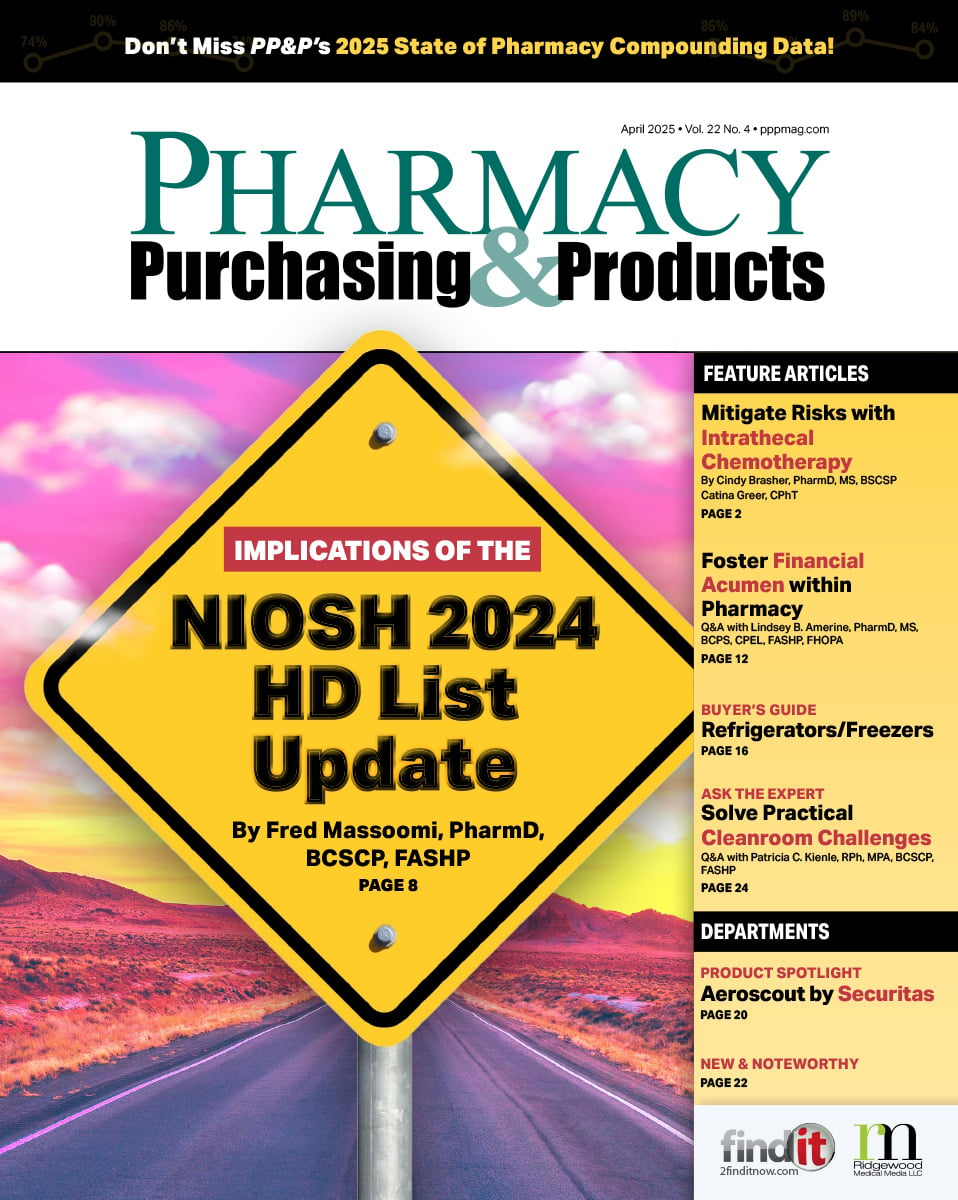- Show Menu
- Contact Us
- FAQs
- Reader Service
- Survey Data
- Survey Winners
- Testimonials
- Upcoming Events
- Webinars
- White Papers
Considerations in Outpatient Pharmacy Renovation

Pharmacies are often renovated or upgraded to meet the changing needs of patients or regulatory requirements, with the goals of medication safety and exceptional customer service driving the process. Eskenazi Health, a 327-bed facility, is well-versed with this process, operating nine outpatient pharmacies, seven of which have been remodeled or rebuilt (see the SIDEBAR). Each renovation has addressed different requirements and challenges, and by sharing the information we have gleaned from our experiences, we hope to assist others in their renovation efforts.
Securing Funding
The process of obtaining funding for construction or remodeling can range from simple to extremely difficult. At the outset, it is important to meet with senior leadership to establish how pharmacy’s plans fit into the overall goals of the institution. Whether your organization operates under continual capital funding, annual funding, or a multi-year capital plan, the best process is to include compelling reasons to support the request, such as regulatory deadlines or physical plant issues that require immediate attention. If needed, prepare a business plan that outlines the return on investment.
A Multidisciplinary Approach
Remodeling or building a pharmacy requires the cooperation of the entire organizational team. List all stakeholders at the beginning of the project as each department must complete their steps before the process begins: Legal must review the contract; finance must agree to fund the project; purchasing must create purchase orders; and accounts payable needs to pay the bills and make sure that everything is billed to the right cost center.
Start by reaching out to your organization’s facilities team. The expertise of this department is invaluable; look for their guidance in terms of accommodating building regulations, as well as understanding how the structure and function of the building will impact your project. Important questions they can answer include:
- Is an adequate power supply available?
- Is the power source located under the floor or will it drop down from the ceiling?
- Where are the water and sewage pipes located for sink connections?
Additionally, the information systems/information technology (IS/IT) department can provide crucial direction when remodeling or building. Even the most conscientiously built structure requires computers and automation to run it, so involve your IS/IT department early in your planning process. They will establish the appropriate server configurations and plan for connectivity to all of your vital systems.
Security is another integral department to involve in the pharmacy design process. Address considerations early in the design process such as:
- Establishing perimeter security requirements
- Constructing the walls to connect to the decking above
- Placement of panic alarms and security cameras
- Location of a secondary exit(s)
Each stakeholder must sign off on their part prior to commencing construction in order to avoid expensive changes or delays during the build process, or worse, rework after the construction is completed.
Planning Considerations
When planning a new pharmacy, start by considering placement within the building. In our experience with outpatient pharmacies, we often build in the front of the building. Coupled with electronic prescribing, this allows patients to pick up new medications on their way out of the building after their visit and ensures easy access for patients picking up refills without interfering with the traffic flow within the building.
Next, determine the square footage necessary to accommodate the pharmacy’s current and future workflows. Pharmacy size considerations should be based on expected prescription volume, medication storage needed to support the volume, and staffing needs. Examine both patient flow and pharmacy workflow to design for efficiency.
Once you have determined the size of the pharmacy and where it will be located, the next step is to plan the design. As this is a significant undertaking, take advantage of your vendor’s experience with designing pharmacies. Once you establish the proposed workflow, then you can choose the casework needed to support this vision. This plan should be shared with your facilities department to make sure that you receive an accurate budget estimate to present to senior leadership.
Choosing a Vendor
When choosing a vendor, we look for a company with significant pharmacy experience. The vendor must understand pharmacy workflow to assist with the design. An experienced vendor can leverage their years of experience to help avoid missteps. They can also be a great resource in identifying what the current trends are.
To gain an understanding of a vendor’s experience in pharmacy design, review the company’s portfolio to see some of their previous work. Ask for customer references from the vendor and follow up with them. When feasible, set up a site visit to walk through the pharmacy to experience the layout and casework firsthand.
Finally, make sure to choose a vendor that understands the importance of building for future flexibility and expansion. Based on our renovation experience, we recommend purchasing modular casework rather than built-ins as this will provide sufficient flexibility to accommodate future changes. With modular units pharmacy can be reconfigured as the need arises with minimal cost. Over time, you may need a new module or a new countertop, but that cost is insignificant compared to deconstructing and reconstructing built-ins.
Design Improvements
Patient Experience
Renovations can be a great opportunity to address the continually changing needs of patients. New considerations should include reviewing patient flow in the lobby, and then building and furnishing to reinforce social distancing. For example, our vaccination business has grown considerably over the years, and we expect continued growth with the expansion of COVID-19 vaccinations and boosters, in addition to our regular focus on influenza. To address this area of growth, we have added vaccination/consultation rooms to all our remodeled sites. These rooms serve a dual purpose as they provide privacy for patients receiving vaccinations while allowing the pharmacist to remain in the licensed area, and they allow for patient/pharmacist conversations that might be uncomfortable to conduct at the prescription counter.
Staff Experience
Renovation allows you to design the optimal workflow for your staff as well as your patients. Use proximity and workflow to decrease unnecessary steps and place all the appropriate tools at the staff’s fingertips. This is the perfect time to talk about and implement ergonomics. Place monitors and keyboards in the optimal location. Assign each station as sitting or standing, and plan accordingly in the design. Determine what functions will occur at each workstation and build each work area to perform as many tasks as possible to allow for easier workflow on those days when you are understaffed.
Another innovative feature that we include in our outpatient pharmacies is an employee window. This allows the clinic staff to come to a side window to receive service quickly and efficiently without having to cut through a line of patients. Staff in the back of the pharmacy are designated to service the clinic staff so that they can get back to work quickly. This has improved the sense of teamwork between the pharmacy and clinic staff. It also is a great way to increase the capture of employee prescriptions. Employees appreciate the opportunity to pick up their personal prescriptions without having to wait in line with the patients.
Conclusion
There are many factors to consider when renovating an outpatient pharmacy. From the planning stages to choosing a vendor, it is important to look for ways to also improve the overall experience for both staff and customers. Consider staff and patient workflows early in the planning process and be sure to include all stakeholders before construction begins. This holistic approach will help ensure that renovations elevate the pharmacy to deliver a better experience. Ultimately, every renovation should improve your ability to run a lean operation, while simultaneously supporting the delivery of a high-level of service.
 Todd Bailey-Cox, PharmD, is a manager for the outpatient pharmacies at Eskenazi Health in Indianapolis, Indiana. He received his PharmD from Purdue University. In Todd’s 22 years as outpatient pharmacy manager, he has overseen the construction or remodeling of seven pharmacies.
Todd Bailey-Cox, PharmD, is a manager for the outpatient pharmacies at Eskenazi Health in Indianapolis, Indiana. He received his PharmD from Purdue University. In Todd’s 22 years as outpatient pharmacy manager, he has overseen the construction or remodeling of seven pharmacies.
SIDEBAR
About Eskenazi Health
For more than 160 years, Eskenazi Health has provided high-quality, cost-effective, patient-centered health care in central Indiana. Accredited by The Joint Commission, Eskenazi Health’s nationally recognized programs include a Level I trauma center, a regional burn center, a comprehensive senior care program, women’s and children’s services, teen and adolescent care programs, the Lifestyle Health & Wellness Center, the Sandra Eskenazi Mental Health Center, and a network of primary care sites located throughout the neighborhoods of Indianapolis known as Eskenazi Health Center. Eskenazi Health also operates nine retail pharmacies.
The common driving factor behind most of our outpatient pharmacy renovations has been the need to upgrade our facilities to meet the continually changing needs of our patients. With each renovation, we seek to efficiently deliver exceptional customer service to patients, while also updating the infrastructure to support the expansion our service offerings. Some renovations have been undertaken in response to the need to accommodate new automation and information system adoptions and the resulting process and workflow changes that accompany these adoptions.
Like what you've read? Please log in or create a free account to enjoy more of what www.pppmag.com has to offer.








